-
Countries
-
Data and Analysis
-
Special Focus
-
Crisis Responses
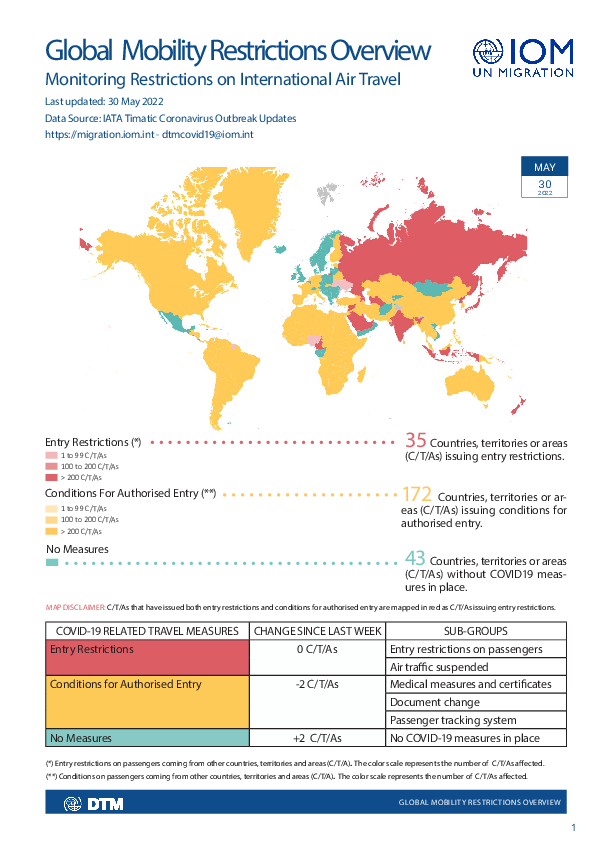
Contact
DTMcovid19@iom.int
Language
English
Location
Global
Period Covered
May 23 2022
May 30 2022
Activity
- Other
The DTM Global Mobility Restrictions Overview provides updates on international air travel restrictions and conditions for authorized entry. This overview aims to understand how COVID-19 has impacted human mobility, detailing how global and regional trends in air travel measures have evolved since COVID-19 was declared a global pandemic in March 2020. The data presented focuses on the changes in public health-related immigration and border management measures. It provides information intended to support IOM missions and partners in targeted response planning and advocacy for vulnerable populations who may be affected by changes in global mobility.

Contact
DTM Nigeria, AllUsersInDTMNigeria@iom.int
Language
English
Location
Nigeria
Period Covered
May 23 2022
May 29 2022
Activity
- Mobility Tracking
- Event Tracking
The DTM Emergency Tracking Tool (ETT) is deployed to track and to collect information on large and sudden population movements, provide frequent updates on the scale of displacement and quantify the affected population when needed. As a sub-component of the Mobility Tracking methodology in Nigeria.
ETT utilises direct observation and a broad network of key informants to capture best estimates of the affected population per location, enabling targeted humanitarian response planning.
Between 23 and 29 May 2022, a total of 2,088 movements were recorded in Adamawa and Borno States. The recorded movements consisted of 1,642 arrivals and 446 departures. Arrivals were recorded at locations in Askira/Uba, Bama, Damboa, Gwoza, Kala/Balge, Monguno and Ngala Local Government Areas (LGAs) of the most conflict-affected state of Borno and in Fufore, Girei, Gombi, Hong, Lamurde, Maiha, Michika, Mubi South, Numan, Song, Yola North and Yola South LGAs of Adamawa State.
Departures were recorded in Askira/Uba, Gwoza and Kala/Balge LGAs of Borno State and in Fufore, Gombi, Hong, Maiha, Mubi North, Mubi South, Song and Yola South LGAs of Adamawa State.
ETT assessments identified the following movement triggers: poor living conditions (913 individuals or 44%), seasonal farming (548 individuals or 26%), military operations (323 individuals or 16%), improved security (170 individuals or 8%), voluntary relocation (50 individuals or 2%), family re-unification (44 individuals or 2%), lack of humanitarian assistance (22 individuals or 1%) and access to humanitarian support (18 individuals or 1%).
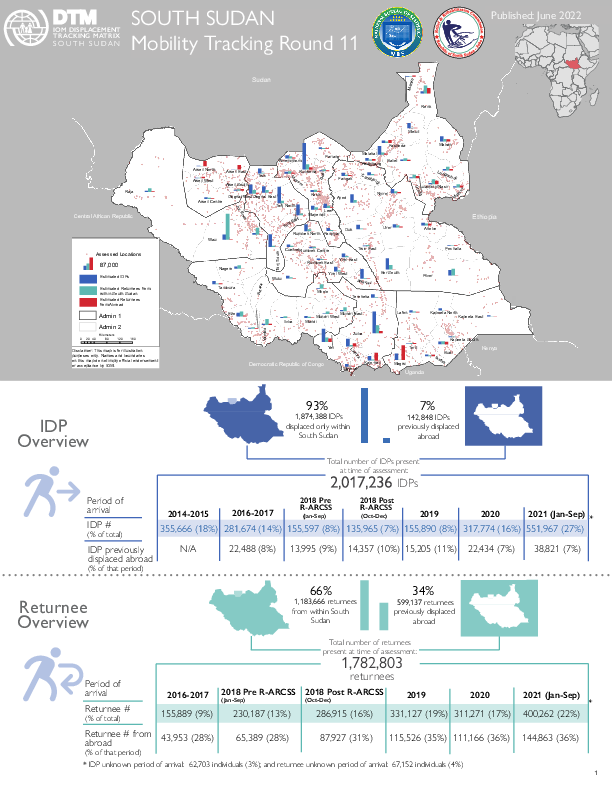
Contact
DTM South Sudan, SouthSudanDTM@iom.int
Language
English
Location
South Sudan
Period Covered
Jul 01 2021
Sep 30 2021
Activity
- Mobility Tracking
- Baseline Assessment
As of September 2021, there has been an increase in the total number of Internally Displaced Persons (IDPs), relative to December 2020. The data reflects a continuation of the significant impact of natural disasters, which was already observed in 2019 and 2020. Conflict remains the main reason for those in protracted displacement who left their areas of habitual residence before the signing of the peace agreement in 2018. The number of returnees in re-assessed sites has decreased (-31,065 returnees), and hence this is indicative of a downward trend in returnee numbers. Although the overall number of returnees did increase, this is driven by the coverage of new locations and the returnee counts therein (+108,357 returnees for new locations).
Data collection for Mobility Tracking Round 11 took place from July to September 2021 – during the rainy season – following Round10 which concluded in December 2020. The DTM team assessed 3,335 locations across all 10 states and 78 counties.
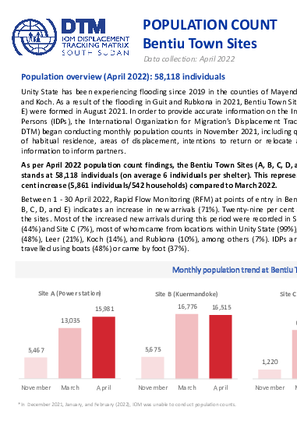
Contact
DTM South Sudan, SouthSudanDTM@iom.int
Language
English
Location
South Sudan
Period Covered
Apr 01 2022
Apr 30 2022
Activity
- Registration
- Flow Monitoring
- Mobility Tracking
- Site Assessment
As per April 2022 population count findings, the Bentiu Town Sites ( B, C, D, and E) population stands at 58,118 individuals (on average 6 individuals per shelter). This represents an eleven per cent increase 5,861 individuals/ 542 households) compared to March 2022.
Unity State has been experiencing flooding since 2019 in the counties of Mayendit, Leer, Panyijiar, and Koch. As a result of the flooding in Guit and Rubkona in 2021, Bentiu Town Sites (A, B, C, D, and E) were formed in August 2021. In order to provide accurate information on the Internally Displaced Persons (IPDs), the International Organization for Migration’s Displacement Tracking Matrix (IOM DTM) began conducting monthly population counts in November 2021 including questions on areas of habitual residence, areas of displacement, intentions to return or relocate and demographic information to inform partners.

Contact
DTMMAURITANIA.iom.int
Language
English
Location
Mauritania
Period Covered
Apr 01 2022
Apr 30 2022
Activity
- Flow Monitoring
- Event Tracking
Dans le cadre du Suivi des Mouvements de Transhumance, l’OIM met en œuvre un système d’alerte qui a pour objectif de recenser les mouvements inattendus de bétail et les conflits ou catastrophes naturelles liés à l’utilisation des ressources naturelles et aux interactions entre agriculteurs et éleveurs, de comprendre les modes de résolution de conflits existants et d’informer les autorités compétentes, dans l’objectif de réduire les tensions dans les régions d’intervention.
Ce tableau de bord présente les informations fournies par le biais de 21 informateurs clés, présents dans huit régions (Assaba, Brakna, Gorgol, Guidimakha, Hodh El Chargui, Hodh El Gharbi, Tagant et Trarza) pendant le mois d’avril 2022.
Contact
DTM Libya, DTMLibya@iom.int
Language
English
Location
Libya
Snapshot Date
May 31 2022
Activity
- Mobility Tracking
- Site Assessment
Detention Centre Profiling is a component of IOM Libya’s Displacement Matrix programme. It is a data oriented tool that routinely provides specific sex and age demographic data and key sectorial information on individuals held in Libya’s detention centres on the date of assessment.
The Horn of Africa and Yemen is one of the busiest and riskiest migration corridors in the world travelled by hundreds of thousands of migrants, the majority of whom travel in an irregular manner, often relying on smugglers to facilitate movement along the Eastern Route. This regional report provides monthly updates on the complex migratory dynamics through Djibouti, Somalia, Yemen and Ethiopia based on diverse data sources and consultations with key informants in the four countries. Moreover, it provides information on the main protection concerns for migrants along the journey, information on the spill over effects of the conflict in Northern Ethiopia observed at the border between Ethiopia, Kenya and Sudan, a specific focus on children and information on the returns from Saudi Arabia to Ethiopia, Somalia and Yemen.
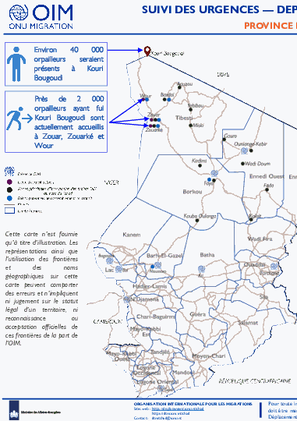
Contact
DTM Tchad, dtmtchad@iom.int
Language
French
Location
Chad
Snapshot Date
Jun 01 2022
Activity
- Mobility Tracking
- Event Tracking
Ce tableau de bord présente les informations sur les mouvements de personnes survenus en fin du mois de mai 2022 dans la province du Tibesti. Des affrontements survenus entre des orpailleurs à Kouri Bougoudi les 23 et 24 mai 2022 ont causé une centaine de morts. Cette localité est une des principales zones d’orpaillage dans le pays et bien qu’aucune étude n’existe sur le nombre d’orpailleurs qui sont y présents, des estimations venant de diverses sources font état d’une présence d’environ 40 000 orpailleurs dans la localité, constitués des migrants internationaux et nationaux.
Suite à cet incident, ces personnes sont contraintes à quitter cette zone (les autorités traditionnelles ont déjà demandé la fermeture des sites d’orpaillage dans la zone). Actuellement, selon les informateurs clés contactés dans la zone, près de 2 000 orpailleurs ont déjà fui Kouri Bougoudi et sont accueillis dans les villes de Zouar, Zouarké et Wour. Selon les autorités locales, ce nombre pourrait continuer à augmenter.
A cause du manque de ressources, ces personnes sont bloquées dans ces villes, dans des conditions de vulnérabilité extrême, en manque de tout service de base. Elles sont en outre exposées à plusieurs risques de protection tels que le trafic et la traite des personnes.
Leurs besoins sont multisectoriels, les quatre principaux étant l’eau, les vivres, les articles non alimentaires et le transport vers leurs zones d’origine.
Un montant de 5 millions de dollars sera nécessaire pour assister ces personnes.
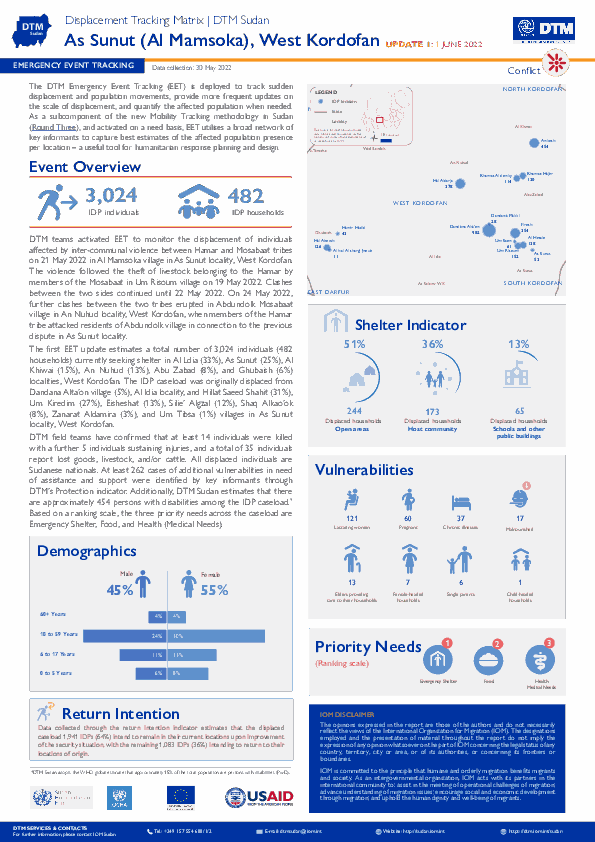
Contact
DTM Sudan; dtmsudan@iom.int
Language
English
Location
Sudan
Snapshot Date
May 30 2022
Activity
- Mobility Tracking
- Event Tracking
The DTM Emergency Event Tracking (EET) is deployed to track sudden displacement and population movements, provide more frequent updates on the scale of displacement, and quantify the affected population when needed. As a subcomponent of the new Mobility Tracking methodology in Sudan (Round Three), and activated on a need basis, EET utilises a broad network of key informants to capture best estimates of the affected population presence per location – a useful tool for humanitarian response planning and design.

Contact
DTM South Sudan, SouthSudanDTM@iom.int
Language
English
Location
South Sudan
Period Covered
Sep 22 2021
Oct 19 2021
Activity
- Survey
- Return Intention
Between September and November 2021, the International Organization for Migration’s Displacement Tracking Matrix (IOM DTM) undertook its second household-level multi-sector assessment of selected urban areas and camps for internally displaced persons (IDPs) in South Sudan. The assessment aims to:
- Quantify the prevalence of vulnerabilities and humanitarian needs across sectors, with a focus on food security, economic vulnerability and nutrition as well as selected indicators on shelter and non-food items (SNFI), education, health, water, hygiene and sanitation (WASH), protection (including child protection and gender-based violence) and mental health and psycho-social support (MHPSS).
- Generate a better understanding of urban displacement and migration, including return and relocation after displacement in South Sudan or abroad.
This survey is part of the country-wide extended Food Security and Nutrition Monitoring System (FSNMS+) assessment in South Sudan, jointly conducted by IOM, the World Food Programme (WFP), the United Nations Children’s Fund (UNICEF), the Food and Agriculture Organization (FAO), the United Nations Office for the Coordination of Humanitarian Affairs (OCHA), REACH and several humanitarian clusters. It was designed to be an independent, crisis-wide and coordinated inter-agency multi-sectoral needs assessment, mandated by the Humanitarian Country Team and endorsed by the Inter- Cluster Coordination Group. Together, the joint findings provide an evidence-base for the Integrated Food Security Phase Classification, the Humanitarian Needs Overview and the Humanitarian Response Plan.
This report presents sectoral findings for the urban area of Yei.
Separate profiles have been published for the urban areas of Juba, Wau, Bor, Malakal and Bentiu / Rubkona.
Further profiles will be published for Juba IDP Camps I and III, Naivasha IDP Camp, Bentiu IDP Camp and Malakal Protection of Civilians (PoC) Site.

